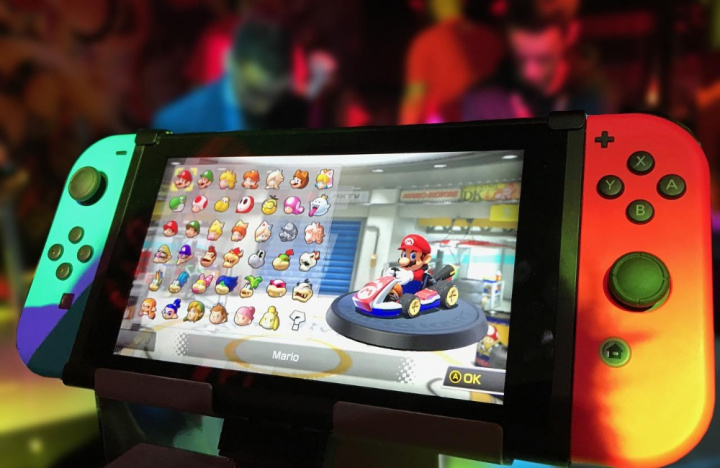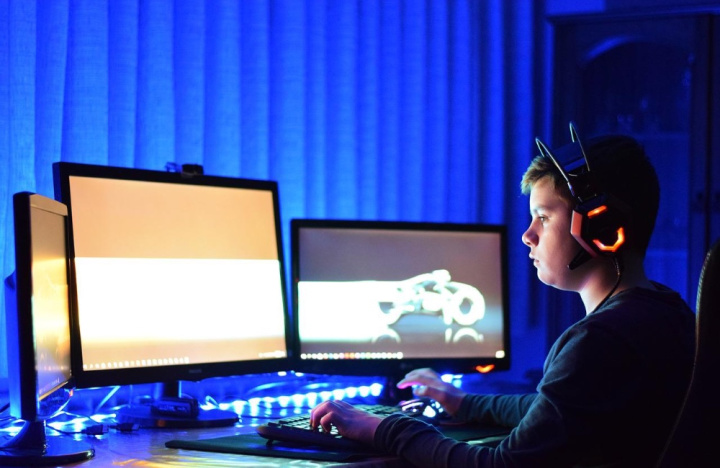What is a Game Designer? What do You Need to Master this Profession?
In the next article from the series of materials about current modern specialties, we will present to your attention the profession of game designer. After reading it, you will learn about what this specialist does, what he needs to know and be able to do, what types of game design there are, and how to master this profession.
Contents:
1. Game designer - who is it? How and when did this specialty appear?
2. What does a game designer do?
3. Game designer responsibilities
4. The stages of the game designer's work
5. What a game designer should know and be able to do
6. How and where to learn game design
7. Conclusion
Today, the game industry is one of the most promising and fastest growing business areas, which has shown truly explosive growth during the pandemic and the lockdowns caused by it. The intensive development of the video game industry has made many specialists associated with it extremely popular, primarily game content developers - game designers.
Game designer - who is it? How and when did this specialty appear?
First of all, to cover this topic, you need to understand the term game design. It refers to a fairly large area that has arisen at the intersection of graphic design, programming and computer science. Game design is considered to be one of the most important tools for the development of modern video games, it flexibly combines creative and technical components.
So, a game designer is a specialist who designs game content and gameplay, develops the rules, goals and mechanics of the game, and creates the basis for the formation of the user's gaming experience. It is important that the profession is responsible not only to develop the concept and design of the game, but also to fully manage the production process. Thus, the specialty of a game designer can be compared to the profession of a product manager or film director.

The profession of “gameplay developer” appeared in the 70s and then it was in demand only in a few game development studios, and game design became a full-fledged specialization in the 80s. At that time, most computer games were created by small groups of enthusiasts, in which the artist worked in tandem with a programmer. Even today, this bunch of game designers and programmers are working on many indie game projects, and in some places both functions are performed by one person. In large studios, you can find separate divisions of game designers with their own hierarchy, each of which has a specific specialization and direction of work.
What does a game designer do?
It is not for nothing that this specialty is called “omnipotent game designer”, as it can have a wide variety of tasks and responsibilities, depending on the specific studio and project. That is why game design is considered a very broad concept, in large studios it includes various segments, including the creation of game content, the design of game worlds and narrative, development interface, etc.
To date, there are the following main areas in the work of a game designer:
- System design. One of the most important areas of game design, which is responsible for creating general rules and concepts of the game. Specialists working in this direction think over game mechanics and their implementation, key features of the game, and write a brief synopsis of its plot. In some studios, a separate employee, Balance Designer, is responsible for balancing game mechanics. It makes sure that the game is not too easy or difficult, and that players and NPCs are as level as possible.
- Content design. Another of the key tasks of game design, which is responsible for the development of all kinds of game content. It includes the creation of characters, items, objects, quests, etc. At this stage, scenarios of behavior and interaction of characters with the main character and with each other are thought out.
- Level-design. This area of game design is entirely dedicated to working out the levels of the game. The level designer creates landscapes of maps and game locations, describes the environment, thinks over the location of objects on the map, etc. locations and spaces for single-player and open-world multiplayer games.
- Narrative design. This type of game design is responsible for the correct presentation of the narrative and its connection with gameplay and other game content (images, text, audio, video). The narrative designer thinks through the creation and interconnection of characters/objects/scenes/quests to consistently reveal the plot of the game. They also pay special attention to text content: the texts of quests, guides, diaries, computer terminals are also part of the narrative design.
- Interface design (UI). This area of game design not only creates the details of the user interface in the game, but also provides all aspects of the player's interaction with the game. The game interface designer ensures that players receive a timely response to their actions in the game, thinks over the appearance and location of buttons, windows and other UI elements.
Game Designer Responsibilities
The work responsibilities of modern game designers are very extensive and diverse. Among them, we can highlight the following:
- Creating a game concept. It is the game designer who comes up with the idea of the game and prescribes its basic concept. It contains game features and mechanics, a brief synopsis of the plot, as well as a list of similar games. All this information is summarized in a concept document.
- Prototype development. Creating a working prototype allows designers and other project participants to assess the prospects for the future game. If necessary, they can make certain changes to the concept document or curtail the project at the preparatory stage due to its futility.
- Development of the gameplay. Game designer is responsible not only for creating individual mechanics and features of the game, but also for developing the gameplay as a whole. During this process, specialists think over the so-called “core of the game” - the main actions of the player and the details of the gameplay (for example, exploring dungeons, fighting monsters, collecting coins/ jewelry, etc.).
- Communication with the team. The most important part of the responsibility of a game designer is to delegate tasks to other project participants: programmers, artists, animators, 3D art company that manages the development of models 3D and 2D modelers, etc. game development: distribute tasks among specialists in a timely manner and monitor the results of their implementation.
- Project promotion and search for publishers. After creating a working prototype of the game, the game designer prepares a presentation (pitch) and starts presenting it to potential publishers. He also continues to communicate with the publisher at all stages of the project and after its release. If a team/studio develops a game without a publisher, then the game designer is looking for alternative sources of funding.
- Maintaining project documentation. The game designer should not only create the overall concept of the game, its mechanics and features, but also ensure that all participants have the same vision of the project. To do this, the development of each game is accompanied by the writing of project documentation, and it is the game designer who updates and keeps it up to date. It includes both a short concept document and a detailed game design document, as well as technical specifications for specific tasks for specialists.
- Planning and monitoring development stages. Since the game designer is essentially a team lead of a game project, he also has to draw up a project implementation plan and monitor the even load of tasks for all team members. The Scrum methodology is most often used for this purpose, but there are other options. Game designer should also regularly monitor the progress of the project and adjust the plan in case of difficulties with the implementation of any task or stage.
- Analytics. Another important responsibility of the game designer specialty is comprehensive project analytics. Before starting development, he analyzes current market trends in order to create a truly promising game that will be successful with the audience. To do this, he needs to follow the current trends in the gaming industry and related areas (movies, cartoons, series, comics, etc.), understand popular genres, settings and game mechanics. After release, this specialist monitors the metrics of the released game, tracking the number of downloads or purchases, the number of new and daily active users, the time they spend playing the game, and the indicators monetization of the game, etc.

The stages of the game designer's work
As for the main stages of a game designer's work on creating a game, they usually go in the following sequence:
- Before launching a project, game designer thinks through the conditions and requirements necessary for its implementation. To do this, it requests the necessary data from analysts and conducts market research. The result of this stage is a basic concept that conveys the main essence of the game, as well as its mechanics, setting, and key features (features).
- After drawing up the basic concept, the game designer presents it to the team. At this stage, an intra-team discussion of the future project takes place, and it is also possible to make changes to the basic concept based on the wishes or comments of the participants.
- After the basic concept has been approved at the team level, the game designer starts working on the concept document. It describes the mechanics and other aspects of the game in more detail, including all the features and in-game logic, and often the concept document includes technical specifications for programmers, artists or other specialists.
- Next, the development team begins to consistently implement all the planned stages. The game designer controls the progress of work, accepts the tasks performed by specialists and makes sure that their result corresponds to the original vision described in the concept and pitch.
- After the product development is completed and it is ready for release, the designer evaluates the result. He reviews the entire set of tasks, checks the compliance of the result with the goals set, assesses the user experience, etc. presents it to the publisher/producer. In case of any comments or recommendations, he organizes and controls the refinement of the game.
- Finally, after the final release of the game, the game designer continues to support the project. At this stage, he monitors analytics and user feedback data, on the basis of which he creates tasks for fixing bugs and improving features, and preparing update releases.
What should a game designer know and be able to do?
If you are going to start working as a game designer, you will need a certain set of hard and soft skills for this. First of all, this specialist must have analytical thinking skills, since successful analytics at the stages of preparation, implementation and after the release of the game is the main factor in its success.
For example, a game designer needs to closely monitor all trends in the computer games market, understand the desires and demands of the target audience, analyze different game settings, mechanics and features to choose the most suitable ones.
Another important skill that a game designer must learn is the preparation of documentation. He spends most of his time working on a project writing concept and design documents. The game designer also has to regularly draw up technical specifications with tasks, instructions and references for programmers, artists and other team members.
In addition, the designer will definitely need the ability to generate ideas, so successful development of this profession requires at least basic creativity. He must also understand modern platforms, tools, and technologies for game development. For example, understand which language is better to develop the interface in, what technologies to use for the server side, which game engine to choose, etc.
As for the soft skills required for a job as a game designer, management skill is considered the most useful among them. He should be able to clearly plan the progress of the project, distribute tasks and calculate deadlines, evaluate the result, prepare comments and edits, control iterations improvements, etc.
In addition, communication skills are very important for a game designer: they must be able to find a common language with different people, communicate their ideas effectively and convince them with their arguments. The ability to prepare presentations for the successful presentation of the project to publishers and producers will also be very useful.

How and where to learn game design?
The profession of game designer is relatively new and therefore very popular, but today there are virtually no training programs for such specialists in Ukrainian universities. Those who want to learn game design can get a specialized higher education abroad or take courses in game designers.
A large number of game design online courses are now available on the Internet, but practice is very important for the full development of this profession. That is, you can become a professional game designer only in the process of direct participation in the game development process.
Therefore, it is advisable to first study to become a game designer at a course, and then get an internship in a game studio or as a June in a game project. You can also try to enter game design through QA (game testing) or create your own indie project in a team with an artist and programmer.
Conclusion
A game designer is the head and ideologist of a game project, whose duties combine tasks in the field of graphic design, programming and management. He develops the concept of the game, looks for publishers and presents his project to them, maintains project documentation, distributes tasks among team members, plans and monitors the progress of the project, analyzes its statistics and user feedback after the release, manages the release of updates, etc.
A professional game designer must understand modern tools and game development technology, be able to generate ideas, have analytics skills and prepare technical documentation, track gaming industry trends. Communication skills, the ability to present and promote the project to publishers, lead the team, and communicate his vision of the product to them are also important for him. You can study to become a game designer in offline or online courses, but then you will need a long internship, which you will have to start as an intern or June in a game development studio.
Do you want to achieve your business, career and life goals faster and better? Do this with Apix-Drive, a tool that removes a significant part of your workflow routine and frees up more time to achieve your goals. Test the capabilities of Apix-Drive for free — see for yourself the effectiveness of the tool.

